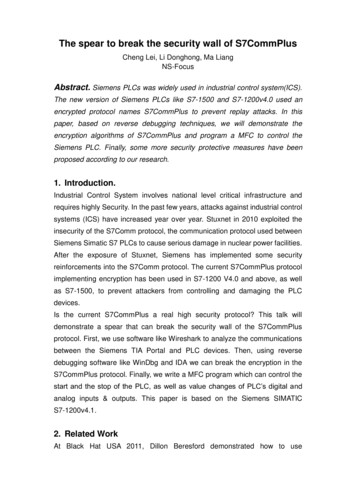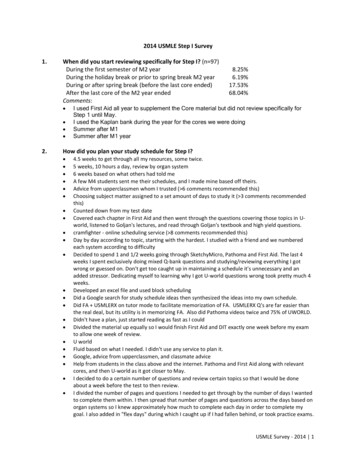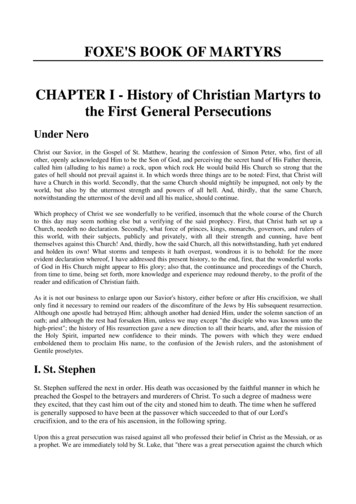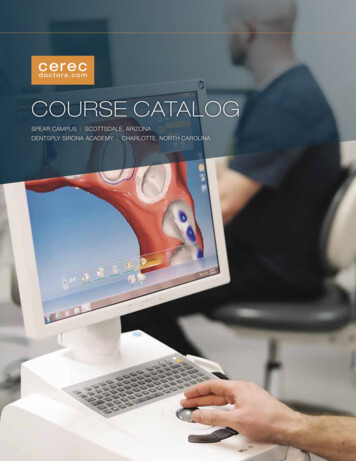
Transcription
The spear to break the security wall of S7CommPlusCheng Lei, Li Donghong, Ma LiangNS-FocusAbstract. Siemens PLCs was widely used in industrial control system(ICS).The new version of Siemens PLCs like S7-1500 and S7-1200v4.0 used anencrypted protocol names S7CommPlus to prevent replay attacks. In thispaper, based on reverse debugging techniques, we will demonstrate theencryption algorithms of S7CommPlus and program a MFC to control theSiemens PLC. Finally, some more security protective measures have beenproposed according to our research.1. Introduction.Industrial Control System involves national level critical infrastructure andrequires highly Security. In the past few years, attacks against industrial controlsystems (ICS) have increased year over year. Stuxnet in 2010 exploited theinsecurity of the S7Comm protocol, the communication protocol used betweenSiemens Simatic S7 PLCs to cause serious damage in nuclear power facilities.After the exposure of Stuxnet, Siemens has implemented some securityreinforcements into the S7Comm protocol. The current S7CommPlus protocolimplementing encryption has been used in S7-1200 V4.0 and above, as wellas S7-1500, to prevent attackers from controlling and damaging the PLCdevices.Is the current S7CommPlus a real high security protocol? This talk willdemonstrate a spear that can break the security wall of the S7CommPlusprotocol. First, we use software like Wireshark to analyze the communicationsbetween the Siemens TIA Portal and PLC devices. Then, using reversedebugging software like WinDbg and IDA we can break the encryption in theS7CommPlus protocol. Finally, we write a MFC program which can control thestart and the stop of the PLC, as well as value changes of PLC’s digital andanalog inputs & outputs. This paper is based on the Siemens SIMATICS7-1200v4.1.2. Related WorkAt Black Hat USA 2011, Dillon Beresford demonstrated how to use
reconnaissance, fingerprinting, replay attacks, authentication bypass methods,and remote exploitation to attack a Siemens Simatic S7-300 PLCs. ThesePLCs use S7Comm protocol which does not contain any security protection.At Black Hat USA 2015, Ralf Spenneberg et. al. demonstrated a worm livesand runs on the Simatic S7-1200v3 PLCs. These PLCs use the earlyS7CommPlus protocol with a simple mechanism to prevent replay attacks.3. Siemens PLCsSiemens PLCs are widely used in industrial control systems, like power plants,fuel gas station, water and waste.3.1 Programmable Logic ControllersProgrammable Logic Controllers (PLC) is responsible for process control inindustrial control system. A PLC contains a Central Processing Unit (CPU),some digital/analog inputs and outputs modules, communication module andsome process modules like PID. Engineers programed user programs forautomated process control in PLC software and then downloaded the userprogram to the PLC. The authorized engineers can also run or stop the PLCsfrom PLC software.3.2 Siemens PLCs protocolsSiemens PLCs use a private protocol to communicate. It is a binary protocolutilizing both TPKT and ISO8073. Typically, both of these protocols use port102/TCP.The newest version of Wireshark(V2.1.1) supports Siemens PLC protocolsrecording that will permit the analysis of message frames. Siemens PLCprotocol has 3 versions, S7Comm protocol, early S7CommPlus protocol andnew S7CommPlus protocol. S7Comm protocol is used in the communicationamong S7-200, S7-300 and S7-400 PLCs. This protocol did not involve anyanti-replay attack mechanism and can be easily exploit by attackers. The earlyS7CommPlus protocol used in the communication among S7-1200v3.0 ismore complicated than S7Comm protocol and use two-byte field calledsession ID for anti-replay attack. However, the session ID is too easy tocalculate. The new S7CommPlus protocol used in the communication amongS7-1200v4.0 and S7-1500 has a complex encryption part to against replayattack. In this paper, we will focus on the encryption part of S7CommPlus.
3.3 TIA PortalTIA Portal is the configuration and programming software for Siemens PLCs.Engineers rely on this software to design logic and program to control theprocess attached to the PLC. The software offers the programmer the ability toconfigure hardware parameters, such as Profinet parameters, communicationtype, diagnostics. Authorized engineers can also run or stop the PLCs, monitorand modify the input/output values.Figure 3.1 TIA Portal CPU STOPFigure 3.2 TIA Portal value monitor and modify
4. Replay AttacksReplay attacks have been widely used in PLC attacks. We build up a small netenvironment with a TIA Portal PC, a PLC and a hub. First, click the Stop PLCbutton in TIA Portal to stop the PLC. Then launch the Wireshark or otherpacket capturing tool to capture the packets between PC and PLC. Once thePLC has stopped, stop capturing the packets. Use the packets we havealready obtained and send these packets back to any PLC in sequence, thePLC could be controlled with these packets.It is also possible for attackers to run PLCs, monitor or modify theanalog/digital input/output values, download user program or system program,monitor the diagnostics of PLC.Figure 4.2 Stop PLC communication sequenceFigure4.1 shows the communication sequence packets when stopping thePLC using Wireshark. We separated these packets into 4 parts, TCPConnection packets, COTP Connection packets, S7CommPlus Connectionpackets and S7CommPlus Function packets. Performance as TIA Portal, firstestablish the TCP connection and COTP connection to the target PLC. Then,send the two S7CommPlus connection packets. After the S7CommPlusconnection was established, the S7CommPlus function packets could be usedto control the target PLC, or read/write the PLC’s input/output values.5. S7CommPlus ProtocolSiemens S7-1200v4.0 and S7-1500 use the new S7CommPlus protocolincluding the S7CommPlus Connection packets and S7CommPlus Functionpackets. Every packets used by S7CommPlus protocol has a similar structure.
Figure 5.1 First S7CommPlus Connection Request PacketFigure 5.1 shows the first S7CommPlus Connection Packet. Byte 0x72represents the start of the S7CommPlus packet. Then following the PDU Typebyte, 0x01 means this packet is a connection packet. The Data Length fielddoes not take into account the frame boundary. Following the Data Length isthe type of this packet, 0x31 means this packet is a request packet. TheSub-type byte further specifies this packet. The sequence number isincremented for each message. Additional data is transferred in separateattribute blocks begin with the two bytes “0xa3, 0x8x”. Frame Boundary is usedas the end of S7CommPlus packet.Figure 5.2 First S7CommPlus Connection Response PacketFigure 5.2 shows the first S7CommPlus Connection response packet. Typebyte 0x32 means this packet is a response packet. The 17th and 18th bytes
presents the Object ID. The 17th byte is constant with the value of 0x87 and the18th byte is a random byte ranges from 0x06 to 0x7f generated by the PLC.The 76th to 95th bytes presents the value array. This value array is a randomarray generated by the PLC.Figure 5.3 Second S7CommPlus Connection Request PacketFigure 5.3 shows the second S7CommPlus Connection packet. The 16th and17th, 21th and 22th bytes is called Session ID. The 16th and 21th byte is constantwith the value of 0x03. The 17th and 22th byte is calculated by TIA Portal withthe following formula:Session ID Object ID 0x80In the second S7CommPlus Connection packet, there are two variable array,we called them Connection Encryption arrays. These two arrays are calculatedby TIA Portal and we will talk this in the next chapter.
Figure 5.4 S7CommPlus Function Request PacketFigure 5.4 shows a S7CommPlus Connection packet. From the 5 th to 37thbytes, is the encryption array. The 5th byte represented the Encryption lengthand the rest represented the Encryption Part which is calculated by TIA Portal.This Encryption Part will be talked in the next chapter.6. Fun with the EncryptionIn chapter 5, we found two encryptions in the S7CommPlus protocol packets,one in the second connection packet and the other in function packets. Usingreverse debugging techniques, we found these encryption is calculated by TIAPortal through a file named OMSp core managed.dll. In this .dll file, TIA Portalgenerated the encryption parts using private algorithms.6.1 Connection packet encryptionThe Connection Encryption arrays in the Second connection packet send byTIA Portal are two 16 bytes’ arrays. These two arrays are both calculated byOMSp core managed.dll.In the first connection response packet, we have already known a randomvalue array generated by the PLC with the length of 20. Using Windbgv6.1.12,we can find this value array is the input parameter for the first encryption ofconnection packet encryption. Figure 6.1 shows a first connection responsepacket send by the PLC. The Value Array is “0xc2, 0x11, 0x70, 0xdf, 0xd4,0x03, 0x6c, 0xf1, 0x52, 0x9f, 0x47, 0x90, 0x1c, 0xd0, 0xca, 0xac, 0x63, 0x7f,0xd5”. Figure6.2 shows a debugging procedure, we found that the eax 244 is“0x70, 0xdf, 0xd4, 0x03, 0x6c, 0xf1, 0x52, 0x9f, 0x47, 0x90, 0x1c, 0xd0, 0xca,0xac, 0x63”. Compare to the first connection response packet, we found thesearrays has the same value in the Value Array’s 3rd to 17th bytes.
Figure 6.1 First S7CommPlus Connection Response Packet with Value ArrayFigure 6.2 First encryption part in the second S7CommPlus Connection packetWith the value array as input, TIA Portal used a XOR (we call this Encryption1)to generated the first encryption part in the second S7CommPlus Connectionpacket:Value Array Encryption1 Connection Encryption Part 1Using the Connection Encryption Part 1 as input, TIA Portal continue its privatealgorithm which is more complex than a XOR(we call this Encryption2) tocalculated the second encryption part in the second S7CommPlus Connectionpacket:Connection Encryption Part 1 Encryption2 Connection Encryption Part 2
Figure6.3 shows the result of Connection Encryption Part 1 and ConnectionEncryption Part 2 from the Windbg and the second S7CommPlus Connectionpacket.Figure 6.3 Encryption part in the second S7CommPlus Connection packet6.2 Function packet encryptionEach function packet send by the TIA Portal has a 32 bytes’ array calledEncryption Part. This array is calculated by OMSp core managed.dll.Using Windbg, we found an array with Session ID in it, is the input parameterof Function packet encryption. Except the Session ID, the other value isconstant, as Figure 6.4 shows.
Figure 6.4 Input parameter for S7CommPlus Function packet encryptionTIA Portal used a complex algorithm (we call this Encryption3) to generatedthe Encryption Part of S7CommPlus Function packet:Constant Array (with Session ID) Encryption3 Function Encryption PartFigure 6.5 Function Encryption part in S7CommPlus Function packetFigure 6.5 shows the result of Function Encryption Part from the Windbg andthe S7CommPlus Function packet.6.3 S7CommPlus CommunicationBased on the research of S7CommPlus protocol encryptions above, we canget the S7CommPlus protocol communication sequence shown in figure 6.6.To establish a connection between the TIA Portal and PLC, the three-wayhandshake TCP connection has been used first. After the COTP connection
(CR & CC), TIA Portal will send an S7CommPlus Connection request. The firstS7CommPlus Connection Response packet include an Object ID and a ValueArray which is generated by the PLC. When receiving the Object ID and theValue Array, the Session ID and Key Block will be calculated by TIA Portal.Then, the second S7CommPlus Connection request packet including SessionID and Key Block will send to the PLC. If the Session ID and Key Block iscorrect, after the verify of PLC, a response packet will be send back to finishthe S7CommPlus connection. Each S7CommPlus Function Request packetinclude an integrity part. The integrity part is calculated by TIA Portal using theSession ID and a fixed Field Value as its input parameter. When the PLCreceives the S7CommPlus Function Request packet, the integrity part will beverified. The S7CommPlus Function Response packet could be send onlywhen the verify was correct.Figure 6.6 S7CommPlus protocol communication sequence with encryptions7. Protections7.1 Code levelUse code confusion techniques and anti-Debug techniques for the key DLLfiles like OMSp core managed.dll. Siemens didn’t do any code protection to
the key DLL files. Therefore, it is very easy for attackers to debug and then findthe encryption algorithm.7.2 Design levelIn the new S7CommPlus protocol, some complex encryption algorithm hastaken by Siemens to against the replay attack. However, the input parameterand the encryption algorithm are not variable. We recommended to use aprivate key as an input parameter for encryption algorithm in thecommunication between Siemens software and PLCs.7.3 Protocol levelEncrypt the whole packets instead of the key byte encryption.8. ConclusionIn this paper, we found that the secure Siemens protocol still has the risk ofbeing exploited. Using reverse debugging techniques, the encryption algorithmof TIA Portal for anti-replay attack can be break. Then, using replay attack, thePLC can be controlled. According to our research, some protections wereproposed in code level, design level and protocol level.REFERENCES[1] Ralf Spenneberg, Maik Brüggemann, Hendrik SchwartkePLC-Blaster: A Worm Living Solely in the PLC. Black Hat 2016 USA[2] Dillon Beresford. Exploiting Siemens Simatic S7 PLCs. Black Hat 2011USA[3] Thomas v2. S7comm Wireshark dissector plugin.http://sourceforge.net/ projects/s7commwireshark/files/.
The spear to break the security wall of S7CommPlus Cheng Lei, Li Donghong, Ma Liang NS-Focus Abstract. Siemens PLCs was widely used in industrial control system(ICS). The new version of Siemens PLCs like S7-1500 and S7-1200v4.0 used an encrypted pro










